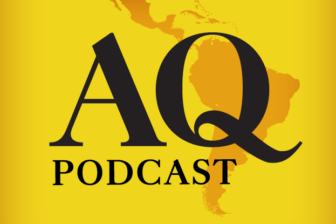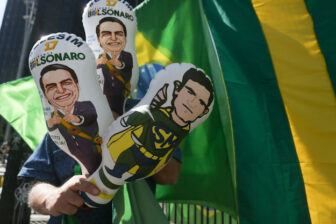MEXICO CITY – 2021 could be a definitive year for anti-corruption in Mexico – but it likely won’t be.
At the end of January, Mexico may learn whether the Public Prosecutor’s Office will proceed with an investigation of former Pemex CEO Emilio Lozoya – or if his participation in a plea deal over the past six months has been enough to walk free.
Even if the government proceeds with a trial for the former executive of Mexico’s state-run energy giant, the case is unlikely to spark a reckoning with corruption on par with Brazil’s groundbreaking, years-long Lava Jato investigation. That’s because, despite President Andrés Manuel López Obrador’s (AMLO) promises of a corruption crackdown, Mexico’s institutions are a far cry from the Brazilian systems that enabled Lava Jato to make an impact.
The Lava Jato investigation is a model for the kind of corruption crackdown many Mexicans want. The case uncovered more than $2.6 billion in embezzled public funds and resulted in some 200 convictions, including of high-ranking executives and senior politicians. But if the case of Lozoya, who fled to Spain last year after being accused of bribery before his extradition in July, continues as it has thus far, no one will so much as set foot in jail.
That’s because Lava Jato’s original guiding values – the meticulous investigation, unprecedented transparency and institutional independence that led to scores of high-profile arrests – are missing in the Lozoya case.
From its very beginning, Brazil’s Federal Police and the Public Prosecutor’s Office established Lava Jato as a high-level investigation. By 2014, prosecutors’ meticulous probing had uncovered a vast network of corruption that linked figures in the upper echelons of Brazilian politics and business.
Prosecutors and investigators then followed a clear strategy: Instead of going after politicians first, prosecutors focused on detaining dozens of businessmen of which they had the more robust proof. In exchange for plea bargains, those arrested revealed information that strengthened prosecutors’ cases, allowing judges to gather enough evidence to convict the investigation’s more elusive targets.
In contrast, the Public Prosecutor’s Office in Mexico has opted to build its entire case based on the testimony of one of its main targets: Lozoya himself, the brilliant ex-director of Pemex. Even now, the majority of what is known about the case comes from Lozoya’s own testimonies — a crucial difference to Brazil, where the prosecution armed itself using cooperation offered by a range of businessmen in exchange for plea deals.
A further fundamental characteristic of Lava Jato was the level of transparency that the case maintained in its early stages. Details of many investigations were made public (often through leaks to the press), allowing the country to follow along as details materialized and the case progressed. In doing so, Lava Jato created an appetite for accountability among members of the public. Consequently, this public hunger for information about the case generally incentivized police investigators, public prosecutors and judges to tread carefully during the case’s early stages. (Public outrage would later fuel politicization of the case).
In Mexico, meanwhile, the only outstanding thing about institutional transparency is its absence. Even though Mexican law dictates that hearings like Lozoya’s must be publicly accessible, at the time of the hearing the general public only learned snippets of what was said via leaked WhatsApp messages. Even more worrying, the foremost sources of public information on the case have been leaks to the media.
Also crucial for Lava Jato was the continued respect for the separation of powers, at least in its early years. Then-President Dilma Rousseff never attempted to intervene or stop the investigation; meanwhile the Senate endorsed Chief Prosecutor Rodrigo Janot and ensured the investigation’s continuity.
It’s worth noting that this separation of powers didn’t last: In early October, President Jair Bolsonaro announced that he had “ended” Lava Jato because political corruption “no longer exists” in Brazil. Current and former prosecutors vehemently disagreed with the decision.
The Lozoya case, meanwhile, has been subject to regular interference. President López Obrador has regularly inserted himself into the case, twisting the narrative for his own political ends. In most of his morning briefings, the president refers to Lozoya in one way or another. In the past, Mexico’s Supreme Court has ruled that extreme media attention can prevent a judge from having an impartial point of view in a case. If AMLO continues to discuss Lozoya’s case, it could be dismissed for violating the presumption of innocence.
And whereas Brazil’s 1988 post-dictatorship constitution created an environment for investigations such as Lava Jato to act autonomously, granting them budgetary independence, empowering prosecutors and devising a professional path for public servants, the autonomy of Mexico’s Public Prosecutor’s Office only dates to a 2014 reform. Only in 2019 did we get our first autonomous public prosecutor. Unlike in Brazil, Mexico has yet to establish an efficient career for public prosecutors, and its criminal investigation system is historically deficient.
There are also a number of technical differences that set Lava Jato apart from the Lozoya case. For example, Mexico’s version of a plea bargain – criterio de oportunidad in Spanish – is much narrower in definition than in Brazil, where plea deals were instrumental to Lava Jato’s impact. In Mexico, some crimes are excluded from plea bargains – domestic violence and tax crimes, for example. Secondly, the information offered in exchange for a deal must be sufficient for prosecutors to go after individuals they believe have committed more serious crimes.
But, as far as the public knows, Lozoya doesn’t know of any crimes more serious than the ones of which he has been accused. Moreover, he is an active participant in almost all of them. Additionally, Lozoya’s testimony may not be sturdy enough to stand alone as sufficient proof to convict others of more serious crimes during the investigation, which is a necessary condition for the agreement to stand in court.
Ultimately, the actual legal process of Lozoya’s case, rather than the political narratives around it, reveals a case that is unlikely to upend corruption in Mexico. But the president has convinced the public that corruption is in fact on the decline, even despite videos that emerged this year showing his own brother receiving a cash payment from a then-employee of the federal government. As of today, none of the participants in the video have been held responsible for anything — a sign that not much as changed in Mexico’s battle against corruption.
All this suggests that the main battle will be for public opinion, and that it will be fought in the media — rather than in the courts. And while I have no doubt that AMLO cares about ending corruption, his preference for morality politics over apolitical prosecution endangers the entire investigation.
If the Lozoya case remains in the spotlight, we will learn about a small number of corrupt deeds undertaken by figures who will, as a consequence, lose public popularity but will remain free. Perhaps this will scratch the surface when it comes to corruption within the government, but Mexico’s tradition of impunity will likely escape unscathed.
—
Vivanco Lira is a lawyer from the Mexico Escuela Libre de Derecho and holds a master’s in legal reasoning from the University of Alicante. He also holds a master’s degree in political theory from the London School of Economics and Political Science, and was a Ph.D. candidate in law at the University of Chile. He is a frequent panelist on the program “Punto y Contrapunto” on ForoTV. Follow him on Twitter @MartinVivanco








